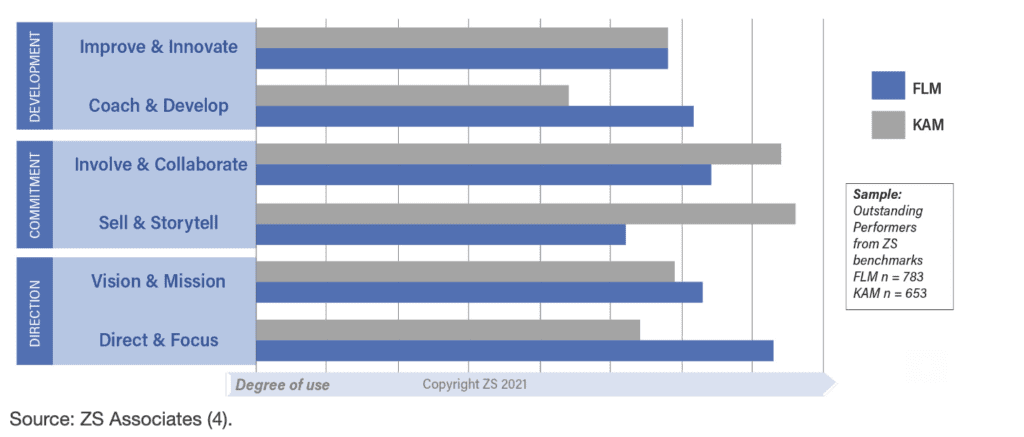KAM Leader Series: Shaping Innovative Solutions
By Dominique Côté
Co-authored by Tania Lennon, Global Space Lead, Talent Assessment and Leadership at ZS and Dominique Côté, CEO and Founder, Cosawi and Principal, The Summit Group
SAMA is proud to offer this 3rd article in the 4-part series on the importance of SAM / KAM leadership. In this series we explore the key capabilities that drive the success of great KAMs and KAM Leaders. Using the experiences of four amazing KAM leaders underpinned by research into KAM leader capabilities for success from ZS, this series of four articles illuminates the foundations of high performance in KAM leadership roles. In addition, this panel of four leaders will be featured at our Annual Conference, May 23-25 in New Orleans. Register here to join us.
As the market becomes more diverse and dynamic, the level of complexity that KAMs face continues to increase. In this context, both KAMs and KAM leaders need to canvass a range of perspectives to understand the problem and find more innovative solutions to address the changing market dynamics. Outstanding KAM leaders can both harness diversity and adapt their leadership style to address the needs of different individuals and cultures (1). Dominique Côté shares her experiences for harnessing diversity to deliver innovative solutions.
Dominique learned the value of diversity through her international experience (2). Dominique grew up in Canada but has led teams spanning 36 countries in her global leadership roles. These experiences developed Dominique’s appreciation for the value that different cultures bring to looking at problems and generating solutions. “One of the regions I led was Middle East, where the culture is grounded in a completely different philosophy in comparison with my home country of Canada. As a consequence, they look at the world through different lenses in line with their cultural values. When you combine diverse perspectives, it enables you to unlock new solutions and ideas for supporting customer success.”
Dominique’s experience aligns with research on the power of collective intelligence. The best predictor of the performance of a diverse group is not how smart the most intelligent group member is: rather, what makes the difference is the level of empathy and social sensitivity demonstrated by group leaders. High performing teams are those in which more people speak up and where more questions are asked to understand the perspectives of others. The level of diversity or the average intelligence of the group is not directly correlated to performance, yet where leaders are able to use their skills to enable the group to listen to each other and build on the ideas of others, groups perform almost 50% better in solving complex tasks and deliver more innovative solutions.
Adaptive leadership harnesses difference
Harnessing the ideas and perspectives of people with very different views is not an easy task, as Dominique describes. “Leading diverse teams requires a lot of humility. You are not the one with the answers: your job is to enable others to find solutions.” It also requires a high level of self-awareness. “Leading in international and diverse settings has encouraged me to become more self-aware. I have a better appreciation of my strengths, which enables me to be more assertive and supportive; I also have an understanding of how to manage or mitigate the areas where I am not so strong. That motivates me to support other people to shine and to encourage people to better appreciate each other’s strengths.”
Self-awareness is both a driver of high performance and a factor that underpins levels of empathy and social sensitivity. In fact, one study found that, without self-awareness, an individual only has a 17% chance of demonstrating empathy for others (3). Self-awareness encompasses both emotional self-awareness – an understanding of your current emotional state and potential triggers that may derail – and accurate self-assessment, which is the realistic self-appraisal of an individual’s strengths and weaknesses, as exemplified by Dominique.
Aligning a diverse team
Dominique applies her strengths as a KAM leader to rally diverse teams by drawing on a wide range of leadership styles. “The starting point is aligning people around a common purpose. A shared vision is what enables KAM leaders to focus the talents and different ways of thinking of the bright and ambitious people we work with. Our role is to awaken that intelligence and ambition, then foster a supportive environment to enable them to be at their best.”
Dominique’s approach reflects a broader trend in the leadership styles utilized by KAMs, as shown in the graph below (4). In comparison with First Line Managers with direct accountability for teams, KAMs tend to place more emphasis on styles such as involvement and storytelling in order to build commitment. They provide big picture direction, sharing the vision and mission for the team and the customer, but provide less specific task direction as they do not typically ‘own’ the resources in the team. As Dominique puts it, “KAM Leaders cannot dictate as leaders: they need to use leadership styles that are more about partnering and listening to create opportunities, growth and positive team environment.”

The graph above shows that KAMs do not tend to use a coaching style as much as FLMs. This is usually because they do not have the same level of investment in team member’s personal and professional development. Dominique sees this as an opportunity for KAMs. “I’m passionate about coaching as a means to help people find their own solutions,” says Dominique. “Coaching is all about asking open questions, guiding people to find the answers for themselves.”
Key capabilities for finding innovative solutions
As customer expectations rise and the market becomes more global and dynamic, KAMs need to utilize all available resources in order to create innovative solutions for customers that provide value and competitive differentiation. Diverse teams offer a prime source of insights and ideas. To harness this resource, KAMs and KAM leaders need to draw upon a broad range of leadership styles. Creating a vision that can align team members is a vital starting point: research suggests that a lack of alignment around goals accounts for about 80% of conflict in teams (5).
There are gender differences in how leaders apply leadership styles (6). Men tend to use leadership styles associated with task delivery more frequently while women tend to use styles that have a stronger people orientation. As the situation becomes complex and the stakeholders and team more diverse, KAM leaders need to leverage more of the people styles, such as coaching, involving and aligning.
By Tania Lennon, Global Space Lead, Talent Assessment and Leadership at ZS and Dominique Côté, CEO and Founder, Cosawi and Principal, The Summit Group
- DeRue, D. S. (2011). Adaptive leadership theory: Leading and following as a complex adaptive process. Research in organizational behavior, 31, 125-150.
2. Woolley, A. W., Chabris, C. F., Pentland, A., Hashmi, N., & Malone, T. W. (2010). Evidence for a collective intelligence factor in the performance of human groups. science, 330(6004), pp. 686-688.
3. Burckle, M. & Boyatzis, R. (1999). “Can you assess your own emotional intelligence? Evidence supporting multi-rater assessment.” Hay/McBer Research Report.
4. Billingsley, T., Thompson, J. & Lennon, T. (2021). KAMs as Leaders: The challenges and benefits of informal leadership. SAMA Conference Presentation, VACA2021.
5. Beckhard, R. (1972). Organizational development. Reading, MA: Addison-Wesley.
6. Eagly, A.H., Johannesen-Schmidt, M.C. and van Engen, M.L. (2003), ‘‘Transformational, transactional, and laissez-faire leadership styles: a meta-analysis comparing women and men’’, Psychological Bulletin, 129(4) pp. 569-91.
Recent Posts
IS YOUR SAM JOURNEY STALLED?
By AKAM Board Members Olivier Rivière (Powering), Armelle Dupont (Vetropak), Dominique Coté (Cosawi)Exploring methodology, governance, and organisation Setting the framework for thinking about K/GAM When considering the design of a Key or Global Account Management...
THE ESSENCE OF KAM/GAM
By AKAM Board Members Olivier Rivière (Powering), Armelle Dupont (Vetropak), Dominique Coté (Cosawi)Exploring methodology, governance, and organisation Setting the framework for thinking about K/GAM When considering the design of a Key or Global Account Management...
Why isn’t Marketing in the KAM/ SAM journey ?
By Dominique CôtéCEO & FounderCosawi Why isn’t Marketing in the KAM/ SAM journey ? Customer-Led and Team-Enabled Marketing In the evolving landscape of Key Account Management (KAM), Account-Based Marketing (ABM) has emerged as a cornerstone for driving...




